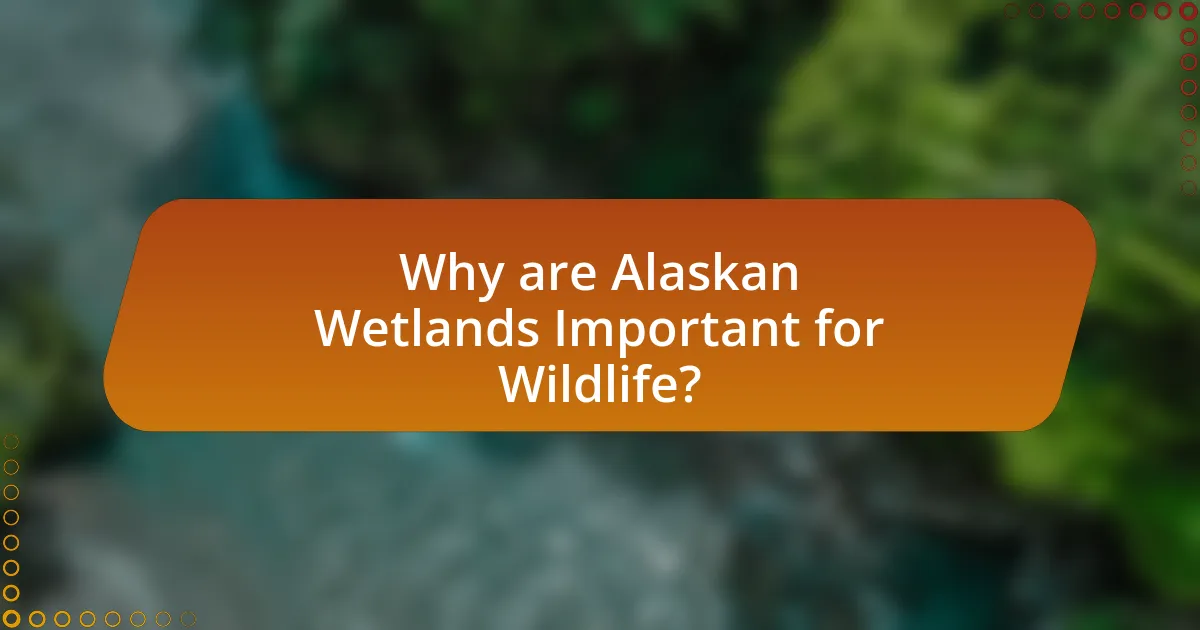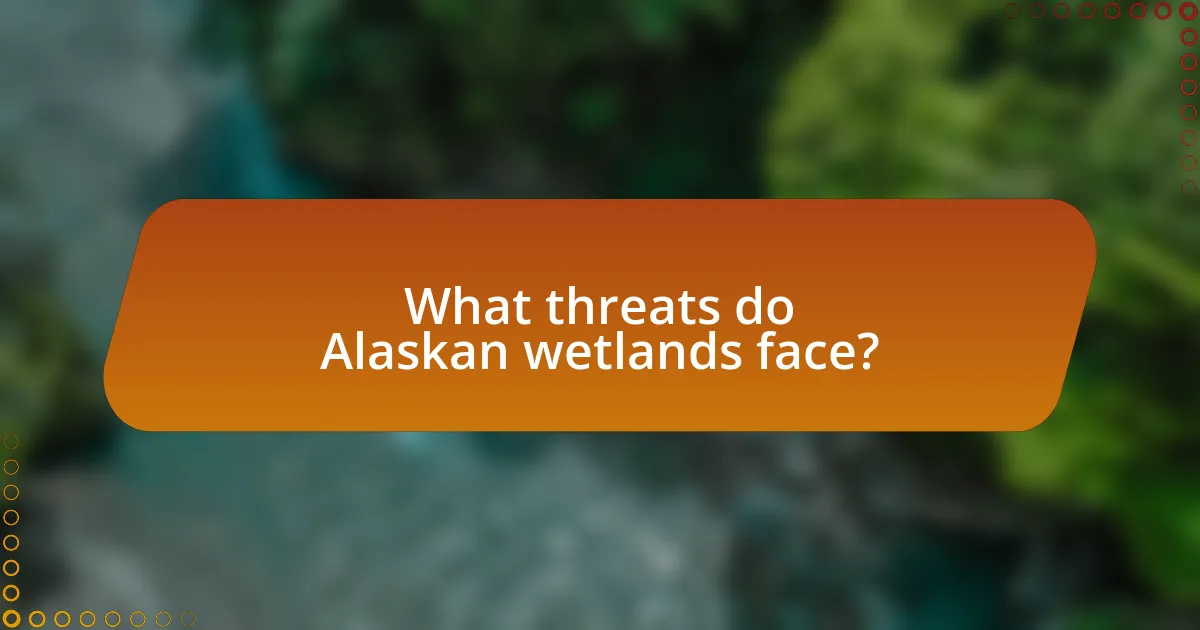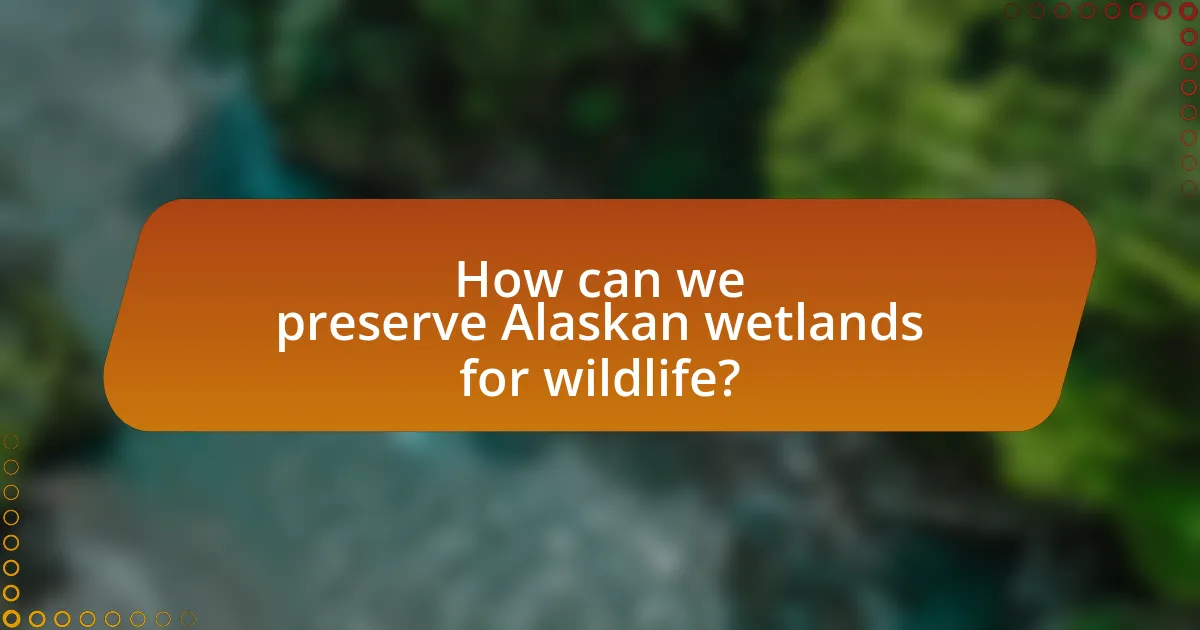Alaskan wetlands are vital ecosystems that provide essential habitats for a diverse range of wildlife, including over 200 species of migratory birds, fish, amphibians, and mammals. These wetlands support critical life cycles, offering breeding grounds, feeding areas, and shelter, while also playing a significant role in maintaining water quality and regulating hydrology. However, they face numerous threats from climate change, oil and gas development, and invasive species, which jeopardize their ecological functions and biodiversity. Effective conservation strategies, including the establishment of protected areas and community involvement, are crucial for preserving these ecosystems and ensuring the survival of the wildlife that depends on them.

Why are Alaskan Wetlands Important for Wildlife?
Alaskan wetlands are crucial for wildlife as they provide essential habitats for a diverse range of species. These ecosystems support migratory birds, fish, and mammals by offering breeding grounds, feeding areas, and shelter. For instance, over 200 species of birds rely on Alaskan wetlands during migration, including the threatened Steller’s eider. Additionally, wetlands serve as nurseries for fish species like salmon, which are vital for both the ecosystem and local economies. The presence of wetlands also helps maintain water quality and regulate hydrology, further supporting wildlife health and diversity.
What types of wildlife depend on Alaskan wetlands?
Alaskan wetlands support a diverse range of wildlife, including migratory birds, fish, amphibians, and mammals. Specifically, species such as the Pacific Black Brant, various waterfowl, salmon, and moose rely on these ecosystems for breeding, feeding, and shelter. The wetlands provide critical habitat for over 200 bird species during migration, with the region serving as a vital stopover point. Additionally, the wetlands are essential for fish spawning, particularly for salmon, which depend on the nutrient-rich waters for their life cycles. The presence of these species underscores the ecological significance of Alaskan wetlands in maintaining biodiversity and supporting wildlife populations.
How do wetlands provide habitat for birds in Alaska?
Wetlands in Alaska provide critical habitat for birds by offering essential resources such as food, nesting sites, and protection from predators. These ecosystems support a diverse range of bird species, including migratory waterfowl and shorebirds, which rely on wetlands for breeding and feeding during their seasonal migrations. For instance, the Yukon Delta National Wildlife Refuge, one of the largest wetlands in Alaska, hosts over 200 species of birds, highlighting the importance of these habitats for avian biodiversity. Additionally, wetlands maintain high productivity levels, providing abundant invertebrates and aquatic plants that serve as food sources for birds.
What role do wetlands play in the life cycles of amphibians and reptiles?
Wetlands are crucial for the life cycles of amphibians and reptiles as they provide essential habitats for breeding, feeding, and shelter. Amphibians, such as frogs and salamanders, rely on wetlands for laying eggs in water, which is necessary for their aquatic larvae to develop. Reptiles, including turtles and certain snakes, also utilize wetlands for nesting sites and as a source of moisture. Research indicates that wetlands support high biodiversity, offering a rich array of food sources and protection from predators, which is vital for the survival of these species during various life stages. The loss of wetlands can lead to significant declines in amphibian and reptile populations, highlighting the importance of preserving these ecosystems for their continued existence.
How do Alaskan wetlands contribute to biodiversity?
Alaskan wetlands significantly contribute to biodiversity by providing critical habitats for a diverse array of plant and animal species. These ecosystems support over 200 species of migratory birds, including waterfowl and shorebirds, which rely on wetlands for nesting and feeding. Additionally, wetlands serve as nurseries for fish species such as salmon, which are vital to both the local ecosystem and the economy. The unique hydrology and vegetation of Alaskan wetlands create a rich environment that fosters high levels of species richness and endemism, making them essential for maintaining ecological balance and resilience in the face of environmental changes.
What specific species thrive in Alaskan wetland ecosystems?
Specific species that thrive in Alaskan wetland ecosystems include the American black duck, the northern pintail, and various species of shorebirds such as the sandhill crane and the lesser yellowlegs. These species rely on the wetlands for breeding, feeding, and migratory stopovers. Alaskan wetlands provide critical habitat that supports diverse wildlife populations, with over 200 bird species utilizing these areas during different seasons, highlighting their ecological significance.
How do wetlands support migratory patterns of wildlife?
Wetlands support migratory patterns of wildlife by providing essential habitats that offer food, shelter, and breeding grounds. These ecosystems serve as critical stopover points for migratory birds, allowing them to rest and refuel during long journeys. For instance, the Alaska Peninsula and the Yukon-Kuskokwim Delta are recognized as vital migratory pathways, where wetlands provide abundant resources such as invertebrates and aquatic plants that sustain various species. Studies indicate that over 50% of North America’s migratory waterfowl rely on wetland habitats during migration, highlighting their importance in maintaining healthy wildlife populations.
What ecological functions do Alaskan wetlands serve?
Alaskan wetlands serve critical ecological functions, including water filtration, flood control, and habitat provision for diverse wildlife. These wetlands filter pollutants and sediments from water, improving water quality in surrounding ecosystems. They also act as natural buffers, absorbing excess rainfall and reducing the risk of flooding in adjacent areas. Furthermore, Alaskan wetlands provide essential habitats for numerous species, including migratory birds, fish, and mammals, supporting biodiversity and ecological balance. Studies indicate that wetlands in Alaska are vital for the survival of various species, highlighting their importance in maintaining healthy ecosystems.
How do wetlands filter pollutants and improve water quality?
Wetlands filter pollutants and improve water quality through natural processes such as sedimentation, absorption, and microbial activity. These ecosystems trap sediments and contaminants, allowing them to settle out of the water column, while plants and soil microorganisms absorb nutrients and break down harmful substances. Research indicates that wetlands can remove up to 90% of nitrogen and phosphorus from water, significantly reducing nutrient pollution that can lead to harmful algal blooms. This filtration process not only enhances water clarity but also supports diverse wildlife by maintaining a healthier aquatic environment.
What is the significance of wetlands in carbon storage and climate regulation?
Wetlands play a crucial role in carbon storage and climate regulation by sequestering significant amounts of carbon dioxide from the atmosphere. They are estimated to store about 30% of the world’s soil carbon, despite covering only 6% of the Earth’s surface. This carbon storage capacity helps mitigate climate change by reducing greenhouse gas concentrations. Additionally, wetlands regulate local climates by maintaining humidity and temperature levels, which further supports biodiversity and ecosystem health. Their ability to absorb and release water also contributes to flood control and water quality improvement, reinforcing their importance in climate regulation.

What threats do Alaskan wetlands face?
Alaskan wetlands face significant threats primarily from climate change, oil and gas development, and invasive species. Climate change leads to altered hydrology, increased temperatures, and permafrost thawing, which disrupts the delicate ecosystems of these wetlands. Oil and gas development poses risks through habitat destruction, pollution, and the potential for spills, which can have devastating effects on local wildlife. Invasive species, introduced through human activity, can outcompete native flora and fauna, further destabilizing these ecosystems. Collectively, these threats jeopardize the biodiversity and ecological functions that Alaskan wetlands provide.
How does climate change impact Alaskan wetlands?
Climate change significantly impacts Alaskan wetlands by altering hydrology, increasing temperatures, and affecting vegetation. These changes lead to the loss of wetland area, as rising temperatures cause permafrost thawing, which in turn affects water retention and flow patterns. According to the U.S. Geological Survey, approximately 50% of Alaskan wetlands could be lost by the end of the century due to climate change, which threatens the diverse wildlife that relies on these ecosystems for habitat and food sources.
What are the effects of rising temperatures on wetland ecosystems?
Rising temperatures negatively impact wetland ecosystems by altering hydrology, increasing evaporation rates, and promoting the growth of invasive species. These changes can lead to reduced water levels, which affect the habitat availability for various wildlife species that depend on wetlands for survival. For instance, studies indicate that a 1°C increase in temperature can decrease wetland water levels by approximately 10%, significantly impacting biodiversity. Additionally, warmer temperatures can enhance the proliferation of invasive plant species, which outcompete native flora, further disrupting the ecological balance.
How does melting permafrost affect wetland stability?
Melting permafrost destabilizes wetlands by altering hydrology and increasing soil erosion. As permafrost thaws, it releases stored water, leading to changes in water levels and flow patterns, which can disrupt the ecological balance of wetland habitats. Research indicates that the thawing process can also result in the release of greenhouse gases, further impacting climate and wetland stability. A study published in the journal “Nature Climate Change” by Schuur et al. (2015) highlights that permafrost thaw contributes to increased carbon emissions, which can exacerbate climate change and further destabilize wetland ecosystems.
What human activities threaten the preservation of Alaskan wetlands?
Human activities that threaten the preservation of Alaskan wetlands include oil and gas exploration, urban development, agriculture, and climate change. Oil and gas exploration disrupts the natural landscape and can lead to contamination of water sources, while urban development encroaches on wetland areas, reducing their size and ecological function. Agriculture contributes to wetland degradation through drainage practices and the introduction of pollutants. Climate change exacerbates these threats by altering hydrology and increasing the frequency of extreme weather events, which can lead to further loss of wetland areas. These activities collectively undermine the ecological integrity of Alaskan wetlands, which are vital for wildlife habitat and biodiversity.
How does urban development encroach on wetland areas?
Urban development encroaches on wetland areas primarily through land conversion for residential, commercial, and industrial purposes. This process often involves draining wetlands, filling them with soil or debris, and altering natural water flow, which disrupts the ecological balance. According to the U.S. Environmental Protection Agency, approximately 50% of the original wetlands in the contiguous United States have been lost due to urbanization and agricultural expansion. This loss not only diminishes biodiversity but also affects water quality and flood control, highlighting the critical need for preserving these ecosystems, particularly in regions like Alaska where wetlands serve as vital habitats for wildlife.
What role does agriculture play in wetland degradation?
Agriculture significantly contributes to wetland degradation through practices such as drainage, land conversion, and the use of fertilizers and pesticides. These agricultural activities lead to the loss of wetland areas, as they often require the alteration of natural landscapes to create arable land. For instance, the conversion of wetlands into farmland can result in habitat destruction and a decline in biodiversity. Additionally, the runoff from agricultural fields introduces pollutants into wetland ecosystems, further degrading water quality and disrupting the ecological balance. Studies have shown that agricultural expansion is one of the leading causes of wetland loss globally, with estimates indicating that over 50% of the world’s wetlands have been lost since the 1900s, primarily due to agricultural development.

How can we preserve Alaskan wetlands for wildlife?
To preserve Alaskan wetlands for wildlife, implementing conservation strategies such as establishing protected areas, restoring degraded habitats, and regulating land use is essential. Protected areas, like national parks and wildlife refuges, safeguard critical habitats from development and pollution, ensuring that wildlife has a safe environment to thrive. Restoration efforts, such as replanting native vegetation and removing invasive species, help to rehabilitate wetlands that have been damaged, thereby enhancing biodiversity. Additionally, regulating land use through policies that limit industrial activities and promote sustainable practices can prevent further degradation of these vital ecosystems. According to the U.S. Fish and Wildlife Service, Alaska’s wetlands support over 200 species of birds and numerous fish and mammal species, highlighting the ecological importance of these areas.
What conservation strategies are effective for protecting wetlands?
Effective conservation strategies for protecting wetlands include establishing protected areas, implementing sustainable land-use practices, and restoring degraded wetlands. Protected areas, such as national parks and wildlife refuges, safeguard critical wetland habitats from development and pollution, ensuring the preservation of biodiversity. Sustainable land-use practices, including controlled agricultural practices and responsible urban planning, minimize the impact on surrounding wetlands, reducing runoff and habitat destruction. Additionally, wetland restoration projects, which involve re-establishing native vegetation and hydrology, have been shown to enhance ecosystem functions and improve water quality. For instance, the U.S. Fish and Wildlife Service reports that wetland restoration can increase habitat availability for migratory birds and other wildlife, demonstrating the effectiveness of these strategies in maintaining wetland ecosystems.
How do protected areas and reserves contribute to wetland preservation?
Protected areas and reserves contribute to wetland preservation by providing legal protection and management that restricts harmful activities such as development, pollution, and resource extraction. These designated areas help maintain the ecological integrity of wetlands, which are crucial for biodiversity, water filtration, and flood control. For instance, the establishment of the Arctic National Wildlife Refuge in Alaska has safeguarded vital wetland habitats for numerous species, including migratory birds and fish, thereby supporting both wildlife conservation and ecosystem health.
What role do local communities play in wetland conservation efforts?
Local communities play a crucial role in wetland conservation efforts by actively participating in the management and protection of these ecosystems. Their involvement includes traditional ecological knowledge, which enhances conservation strategies, and local stewardship initiatives that promote sustainable practices. For instance, studies have shown that communities engaged in wetland monitoring and restoration projects can significantly improve biodiversity outcomes and habitat quality. Additionally, local advocacy for policy changes often leads to stronger legal protections for wetlands, as seen in various Alaskan initiatives where community input has shaped conservation policies.
What policies and regulations support wetland preservation in Alaska?
The policies and regulations that support wetland preservation in Alaska include the Clean Water Act, the Alaska Wetlands Conservation Plan, and the Alaska National Interest Lands Conservation Act. The Clean Water Act establishes a framework for regulating the discharge of pollutants into waters, including wetlands, and requires permits for activities that may impact these ecosystems. The Alaska Wetlands Conservation Plan, developed by state and federal agencies, aims to protect and manage Alaska’s wetlands through coordinated efforts and stakeholder involvement. The Alaska National Interest Lands Conservation Act designates significant areas of land, including wetlands, for conservation and restricts development activities that could harm these habitats. These regulations collectively ensure the protection of wetland ecosystems, which are vital for wildlife habitat, water quality, and flood control in Alaska.
How do federal and state laws protect wetland ecosystems?
Federal and state laws protect wetland ecosystems primarily through regulatory frameworks that govern land use and water quality. The Clean Water Act, enacted in 1972, is a key federal law that regulates the discharge of pollutants into waters, including wetlands, and requires permits for activities that may impact these ecosystems. Additionally, the National Wetlands Inventory, managed by the U.S. Fish and Wildlife Service, provides data on wetland locations and conditions, aiding in conservation efforts. State laws often complement federal regulations by establishing specific protections tailored to local wetland ecosystems, such as requiring state permits for wetland alterations and promoting restoration initiatives. These combined efforts are crucial for maintaining the ecological integrity of wetlands, which serve as vital habitats for wildlife, including many species endemic to Alaskan wetlands.
What initiatives exist to restore degraded wetlands in Alaska?
Initiatives to restore degraded wetlands in Alaska include the Alaska Wetlands Initiative, which focuses on habitat restoration and conservation efforts, and the National Oceanic and Atmospheric Administration’s (NOAA) Coastal Wetlands Program, which funds projects aimed at restoring wetland ecosystems. Additionally, the U.S. Fish and Wildlife Service implements the Partners for Fish and Wildlife Program, which collaborates with landowners to restore wetlands on private lands. These initiatives are supported by scientific research demonstrating the ecological benefits of wetlands, such as improved water quality and enhanced wildlife habitat.
What can individuals do to help preserve Alaskan wetlands?
Individuals can help preserve Alaskan wetlands by participating in local conservation efforts, such as volunteering for wetland restoration projects and supporting organizations focused on wetland protection. Engaging in these activities contributes to the maintenance of biodiversity and the health of ecosystems, which are critical for wildlife habitats. For instance, the U.S. Fish and Wildlife Service reports that wetlands provide essential services, including water filtration and flood control, which are vital for both wildlife and human communities. By advocating for policies that protect wetlands and reducing personal impacts, such as minimizing pollution and responsible land use, individuals can play a significant role in preserving these crucial environments.
How can community involvement enhance wetland conservation efforts?
Community involvement can enhance wetland conservation efforts by fostering local stewardship and increasing public awareness of the ecological importance of wetlands. Engaging community members in conservation activities, such as clean-up events and educational programs, leads to a greater sense of ownership and responsibility towards these ecosystems. Studies have shown that when local populations participate in conservation initiatives, there is a measurable increase in the effectiveness of preservation efforts, as seen in the success of community-led projects in Alaska that have resulted in improved habitat conditions for wildlife.
What practices can individuals adopt to minimize their impact on wetlands?
Individuals can minimize their impact on wetlands by adopting practices such as reducing water usage, avoiding the use of harmful chemicals, and participating in local conservation efforts. Reducing water usage helps maintain the natural hydrology of wetlands, which is crucial for their health. Avoiding harmful chemicals, like pesticides and fertilizers, prevents contamination of wetland ecosystems, protecting the flora and fauna that depend on them. Additionally, participating in local conservation efforts, such as wetland restoration projects, directly contributes to the preservation and enhancement of these vital habitats. These practices are supported by studies indicating that community involvement and responsible resource management significantly benefit wetland ecosystems.


